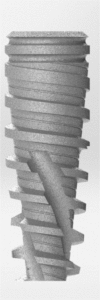Implant stability in different techniques of surgical sites preparation: an in vitro study
- PMID: 25694799
- PMCID: PMC4302746
Implant stability in different techniques of surgical sites preparation: an in vitro study
Abstract
Objective: In the last few decades the implantology has achieved excellent results in the prosthetic rehabilitation of the partially or totally edentulous patients. The clinicians, given the pressing demand by patients, must deal with the situations in which the lack of the availability and sometimes the low quality of the bone can lead to the treatment failure. Although the manufacturers recommend to follow codified surgical protocols, alternative techniques of preparation, apt to ensure a better primary implant stability, have been developed. The aim of this study was to determine in vitro, by using the resonance frequency (Osstell mentor), which technique of implant site preparation (piezo surgery, conventional, under-preparation, bone compaction, osteodistraction) is able to improve implant stability of type IV cancellous bone.
Methods: 10 pig ribs were prepared, and a surgical pre-drilled and calibrated guide for proper implant placement was used. On each rib, 5 implant sites were prepared, one for each technique.
Results: One-way ANOVA did not show statistically significant differences among the "implant stability quotient" (ISQ) values of the 5 techniques utilized.
Conclusions: Thus, in light of these results, in the clinical practice of the type IV bone one technique is replaceable with the others, as none of them improves implant stability. The choice should instead be directed to the technique that accelerates the healing process and the osseointegration.
Keywords: implant site preparation; primary implant stability; resonance frequency analysis.
Figures






Similar articles
-
The effects of surgical preparation techniques and implant macro-geometry on primary stability: An in vitro study.Med Oral Patol Oral Cir Bucal. 2017 Mar 1;22(2):e201-e206. doi: 10.4317/medoral.21286. Med Oral Patol Oral Cir Bucal. 2017. PMID: 28160577 Free PMC article.
-
Primary stability comparison using piezoelectric or conventional implant site preparation systems in cancellous bone: a pilot study.Implant Dent. 2014 Feb;23(1):79-84. doi: 10.1097/ID.0000000000000022. Implant Dent. 2014. PMID: 24398848
-
Comparing the effect of preparation of the implant sites with piezosurgery and conventional drilling on the stability of implants at 5-months follow-up.J Long Term Eff Med Implants. 2018;28(1):1-8. doi: 10.1615/JLongTermEffMedImplants.2018020398. J Long Term Eff Med Implants. 2018. PMID: 29772986 Clinical Trial.
-
Implant Stability Quotients of Osteotome Bone Expansion and Conventional Drilling Technique for 4.1 mm Diameter Implant at Posterior Mandible.Clin Implant Dent Relat Res. 2017 Apr;19(2):253-260. doi: 10.1111/cid.12451. Epub 2016 Sep 25. Clin Implant Dent Relat Res. 2017. PMID: 27665748
-
Piezoelectric surgery versus conventional drilling for implant site preparation: a meta-analysis.J Prosthodont Res. 2018 Oct;62(4):391-396. doi: 10.1016/j.jpor.2018.04.004. Epub 2018 May 26. J Prosthodont Res. 2018. PMID: 29843978 Review.
Cited by
-
Evaluation of the primary stability in dental implants placed in low density bone with a new drilling technique, Osseodensification: an in vitro study.Med Oral Patol Oral Cir Bucal. 2021 May 1;26(3):e361-e367. doi: 10.4317/medoral.24231. Med Oral Patol Oral Cir Bucal. 2021. PMID: 33037795 Free PMC article.
-
Biomechanical Evaluation of Stress Distribution in Subcrestal Placed Platform-switched Short Dental Implants in D4 Bone: In Vitro Finiteelement Model Study.J Pharm Bioallied Sci. 2020 Aug;12(Suppl 1):S134-S139. doi: 10.4103/jpbs.JPBS_44_20. Epub 2020 Aug 28. J Pharm Bioallied Sci. 2020. PMID: 33149444 Free PMC article.
-
Histological and Histomorphometric Insights into Implant Bed Preparation: A Systematic Review.J Clin Med. 2025 Jun 26;14(13):4538. doi: 10.3390/jcm14134538. J Clin Med. 2025. PMID: 40648910 Free PMC article. Review.
-
Mathematical evaluation of the influence of multiple factors on implant stability quotient values in clinical practice: a retrospective study.Ther Clin Risk Manag. 2016 Oct 11;12:1525-1532. doi: 10.2147/TCRM.S113764. eCollection 2016. Ther Clin Risk Manag. 2016. PMID: 27785040 Free PMC article.
-
Multivariate linear regression analysis to identify general factors for quantitative predictions of implant stability quotient values.PLoS One. 2017 Oct 30;12(10):e0187010. doi: 10.1371/journal.pone.0187010. eCollection 2017. PLoS One. 2017. PMID: 29084260 Free PMC article.
References
-
- Brunski JB. Biomechanical factors affecting the bone-dental implant interface. Clin Mater. 1992;10:153–201. - PubMed
-
- Brunski JB. Avoid pitfalls of overloading and micro-motion of intraosseous implants (interview) Dent Implantol Update. 1993;4:77–81. - PubMed
-
- Albrektsson T, Eriksson A. Thermally induced bone necrosis in rabbits: relation to implant failure in humans. Clin Orthop Relat Res. 1985;195:311–312. - PubMed
-
- Albrektsson T, Brånemark PI, Hansson HA, Lindström J. Osseointegrated titanium implants. Requirements for ensuring a long-lasting, direct bone-to-implant anchorage in man. Acta Orthop Scand. 1981;52:155–70. - PubMed
-
- O’Sullivan D, Sennerby L, Meredith N. Measurements comparing the initial stability of five designs of dental implants: a human cadaver study. Clin Implant Dent Relat Res. 2000;2:85–92. - PubMed
LinkOut - more resources
Full Text Sources
